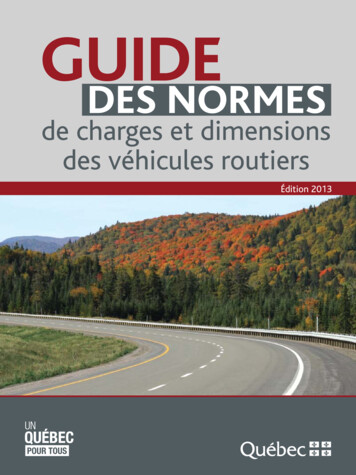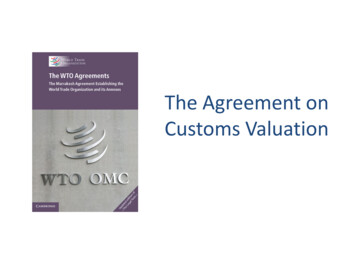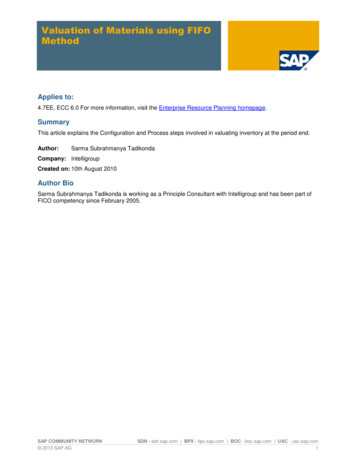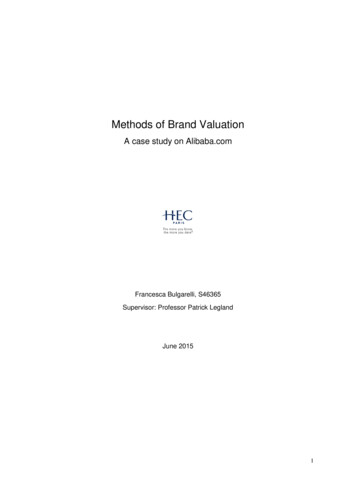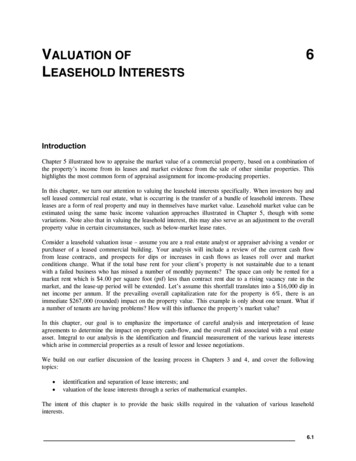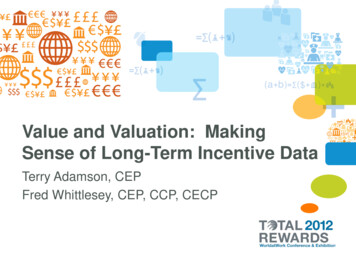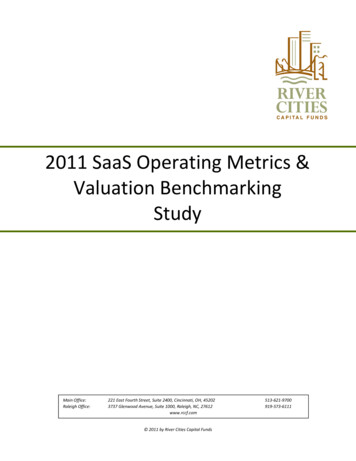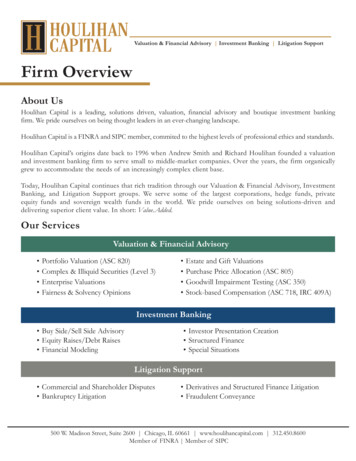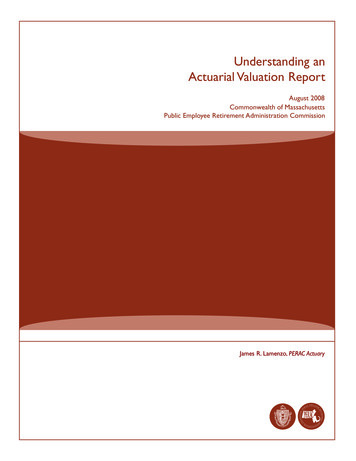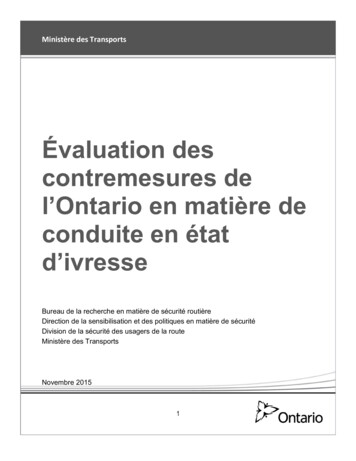
Transcription
Ministère des TransportsÉvaluation descontremesures del’Ontario en matière deconduite en étatd’ivresseBureau de la recherche en matière de sécurité routièreDirection de la sensibilisation et des politiques en matière de sécuritéDivision de la sécurité des usagers de la routeMinistère des TransportsNovembre 20151
The authors thank the following individuals for providing expert advice and forvolunteering their time to take part in our stakeholder meetings: Sheilagh Stewart,Ministry of Attorney General of Ontario; Christine Gilpin, Ontario Provincial Police; RoseDiMarco, Ontario Provincial Police; Mark Wright, Ontario Provincial Police; BrettCarson, Ontario Provincial Police; Scott Rome, Ontario Provincial Police; James Shay,Ontario Provincial Police, Andy Murie, MADD Canada; Robert Man, Centre for Addictionand Mental Health; Robyn Robertson, Traffic Injury Research Foundation, WardVanlaar, Traffic Injury Research Foundation; and Junaid Bhatti, Sunnybrook ResearchInstitute.In addition, the authors thank colleagues in the Safety Policy and Education Branch andthe Licencing Services Branch for providing policy, operations, and public educationconsultation and valuable assistance with data pre-processing. In particular, the authorsrecognize the contribution of Robert Watt, Terri Blackburn, Antonio Loro, Maryam Haya,Karthiga Vezhavendan, Victoria Wood, Nabaa Al Kassab, and Christian Eng fortechnical assistance. The authors would like to extend thanks to Logan Purdy, JessicaMahon, David Silva, Shamaila Mian, Joanna Tsilikas, Francine Rubin, and LloydRobertson for their dedication and availability in providing information consultation andstrategic direction.This work was made possible through the provision of data by the Ministry ofTransportation of Ontario, the Ministry of Attorney General of Ontario, StatisticsCanada, LCBO, Alcolock, and LifeSafer of Canada.This report was prepared by Tracey Ma, Patrick Byrne, Nathalie Chernoff, and YoassryElzohairyCette publication hautement spécialisée Évaluation des contremesures de l'Ontario enmatière de conduite en état d'ivresse n'est disponible qu'en anglais conformément auRèglement 671/92, selon lequel il n'est pas obligatoire de la traduire en vertu de la Liosur les services en français. Pour obtenir des renseignements en français, veuillezcommuniquer avec le ministère des transports au 416-235-4025 ou par courrielà tracey.ma@ontario.ca.2
EXECUTIVE SUMMARYThis report comprises a complete summary of a two-year quantitative evaluationundertaken by the Ministry of Transportation’s Road Safety Research Office to assessthe impact of legislative and regulatory countermeasures implemented by theGovernment of Ontario to reduce alcohol-impaired driving in the province. A variety ofmethodologies were used, each designed to isolate the effects of a particularcountermeasure from other concurrent and/or overlapping measures. Together, theseanalyses provide a comprehensive assessment of the strengths and weaknesses ofeach measure. Although much research has been done on individual drinking anddriving countermeasures across the globe, this assessment of every countermeasureenforced by a single large jurisdiction is the first of its kind. We hope that these findingswill provide a thorough evidenced-based framework to guide future research and policyconsiderations.OVERVIEW OF COUNTERMEASURESOntario’s drinking and driving countermeasures target novice-classed drivers, youngdrivers, and members of the general driving population who drive with unsafe bloodalcohol concentrations (BAC). Some of these countermeasures involve sanctions thatare administered upon detection of an offence, while others are contingent uponconviction for an offence. The evaluated countermeasures are: 90-day Administrative Driver’s Licence Suspension Warn Range Sanctions Long Term Vehicle Impoundment Seven-day Vehicle Impoundment Zero BAC Requirements Alcohol Education and Treatment Remedial Measures Program Ignition Interlock Program Reduced Suspension with Ignition Interlock Conduct Review ProgramOVERVIEW OF EVALUATIONFor each of the eight countermeasures, specific research questions were defined basedon the intended and/or expected impact of that countermeasure. The resultingquestions can be divided into two broad categories: those investigating general3
deterrence (i.e., effects of a countermeasure’s existence on the behavior of all drivers)and those investigating specific deterrence (i.e., effects of a countermeasure on thebehaviour of those drivers who have been subject to it). Questions of generaldeterrence were typically addressed using collision outcomes, such as the number ofdrivers involved in alcohol-related collisions, or the number of injuries and fatalitiesresulting from such collisions. Questions of specific deterrence were typically addressedwith behavioural outcomes, such as repeated drinking and driving incidents (roadsidesanctions and/or later convictions) and driving while suspended incidents. Researchquestions were addressed using a mix of study designs and their corresponding analytictechniques. Data were derived primarily from the Ministry of Transportation’s LicensingControl System and Accident Data System.OVERVIEW OF RESULTS90-day Administrative Driver’s Licence Suspension Since November 1996, a roadside 90-day administrative driver’s licence suspensionis given to a driver who has a measured BAC 0.08%, in violation of Criminal Codeof Canada (CCC) s. 253, or who refuses to submit to screening, in violation of CCC s.254. If existing trends were to have continued from the pre-countermeasure period, therewould have been 90.4 road users per month 1 presenting with major or fatal injuriesresulting from an alcohol-related collisions in the immediate post-implementationperiod. Instead, 71.6 such road users were observed per month postimplementation 2, a 21% decrease. Before countermeasure implementation, there were 2.45 drivers committing a CCC s.253 or 254 re-offence 3 in the 90 days immediately after their initial offence per 100offending drivers. Post-implementation, this number decreased rapidly by 66% to0.82 re-offending drivers per 100 offending drivers.Warn Range Sanctions1Averaged over a five year post-implementation window.All results reported in this executive summary are “statistically significant” at the 𝛼 0.05 level,indicating they are not likely due to random chance.3For the purposes of this report, the term “offence” is defined as an action that lead to conviction, while“re-offence” is defined as the commission of an offence subsequent to a previous commission of thesame offence, where both incidents eventually lead to conviction.24
Since May 2009, a roadside 3, 7, or 30-day administrative driver’s licence suspensionis given to drivers with a measured BAC 0.05%. Additional sanctions apply as well(see main report). If existing trends were to have continued from the pre-countermeasure period, therewould have beeno 179 drinking drivers per month 4 involved in an alcohol-related collision 5 in theimmediate post-implementation period. Instead, 152 such drinking drivers wereobserved per month post-implementation, a 15% decrease.o 261 road users per month presenting with injuries and fatalities from an alcoholrelated collision in the immediate post-implementation period. Instead, 217 suchroad users were observed per month post-implementation, a 17% decrease. The effect of escalating sanctions on a driver’s propensity to drink and drive could notbe evaluated due to data limitations at this time.Long Term Vehicle Impoundment Since February 1999, a 45-, 90-, or 180-day vehicle impoundment is applied to avehicle driven by a driver when that driver is detected driving during a criminal drivingprohibition. The implementation of this countermeasure was associated with a 19% decrease inthe number of criminal driving while prohibited (for CCC s. 253 or 254) offencescommitted by previous offenders 6. This corresponds to a reduction from 23.0offences per 100 years of criminal driving prohibition immediately beforeimplementation to 18.6 immediately after.Seven-day Vehicle Impoundment As of December 2010, a seven-day vehicle impoundment is applied to the vehicledriven by a person when that person receives a 90-day Administrative Driver’sLicence Suspension. The implementation of this countermeasure was associated with ao 33% decrease in the proportion of drivers who were convicted for driving during(and in violation of) their first 90-day administrative driver’s licence suspension.This corresponds to a reduction from 2.12 drivers committing a driving while4Averaged over a 2.5 year post-implementation window.Property damage only collisions were excluded6A previous offender in this instance is someone who was convicted of a driving while prohibited offencein the last 5 years.55
suspended offence per 100 drivers receiving a first 90-day suspension-immediately before implementation--to 1.42 immediately after.o 29% decrease in the proportion of drivers who received a second 90-daysuspension in the three months immediately after the end of their first 90-daysuspension. This corresponds to a reduction from 0.98 drivers incurring a second90-day suspension per 100 drivers who had not yet been (or never were)convicted of the original charge, to 0.71 such drivers per 100.Zero BAC Requirements As of August 2010, drivers under 22 years of age, or who are novice-classed driversare required to maintain a zero BAC while driving. The implementation of this countermeasure was associated with a significantdecrease in the number of 90-day administrative driver’s licence suspensions andWarn Range suspensions incurred by young drivers. Those subject to the Zero BAC suspension as a result of a conviction were less likelyto incur a subsequent warn range or 90-day suspension compared to equivalentdrivers who were charged but not convicted, at least for a specific group ofyoung/novice drivers.Alcohol Education and Treatment Remedial Measures Program Since September 1998, drivers convicted of a criminal drinking and driving offenceare required to undertake alcohol education and/or treatment courses before theirlicence can be re-instated. The remedial measures program, including indefinite suspension for those who didnot complete the program, was associated with decreased drinking and drivingrecidivism that could not be explained by pre-existing recidivism trends. The more-involved program (encompassing assessment, education or treatment, andfollow-up components) was associated with a larger effect than the single-componentprogram (education-only) in reducing recidivism. Program effectiveness was not observed for drivers over 45 years old, suggesting aneed to tailor the program to the demographic characteristics of participants.Ignition Interlock Program As of December 2001, after the end of a driving prohibition period, drivers convictedof a criminal drinking and driving offence are required to install an approved ignitioninterlock device in any vehicle they wish to drive for a prescribed period of time.6
The number of drivers who were detected and charged criminally for drinking anddriving during the period of their ignition interlock condition was 2.49 times higher forthose who did not instal the device compared to those who did install, even aftergroups were made equivalent. No effect on recidivism was observed after the end of the ignition interlock condition.Reduced Suspension with Ignition Interlock Conduct Review Program Starting August 2010, by agreeing to install an ignition interlock device and not “sitout” during an interlock condition (along with other conditions), a driver convicted of acriminal drinking and driving offence for the first time can have their driving prohibitionperiod reduced. Installation of the ignition interlock device increased by 54% at the time of programimplementation. The time period between detection of a drinking driver and subsequent conviction (forthose drivers who were convicted) decreased by 146 days at the time of programimplementation.Our results echo the transportation safety literature in demonstrating that immediate andcertain countermeasures, which, in Ontario, are administratively applied under theHighway Traffic Act (HTA) by the police at the time that the driver is stopped atroadside, are effective at preventing drinking and driving in both the general populationand in the population of previously detected drinking drivers. Increasingcountermeasure severity, on the other hand, is effective primarily in preventing therepetition of drinking and driving behavior for those who have been detected.Approximately 89% of drinking drivers involved in injury/fatality collisions in Ontario in2012 had no history of criminal drinking and driving convictions over the previous tenyears. Moreover, 87% of such drivers had received no administrative roadsidesuspension for BAC 0.08%. This strongly suggests that the largest road safety gainscan be made by focusing on the general deterrence of drinking and driving in thepopulation of persons who have not previously been detected driving while impaired.Our evaluation suggests that administrative sanctions, which are immediate, certain,and target novel driver subgroups and/or circumstances, are effective generaldeterrents when combined with public awareness campaigns and high visibilityenforcement. Any new drinking and driving countermeasures should satisfy thesecriteria. Similarly, any changes to existing countermeasures should be focused onincreasing the immediacy and perceived certainty of consequences.7
Remedial-type countermeasures such as the Alcohol Education and TreatmentRemedial Measures program, Ignition Interlock Program, and the Reduced Suspensionwith Ignition Interlock Conduct Review Program should be simplified and harmonizedwith each other as much as possible for at least two reasons. First, programs with onlya few well-communicated requirements that do not interact in complex ways with otherprograms would simplify operational processes and likely increase participantadherence, a key requirement for program effectiveness. Second, the effectiveness ofa program that interacts in multiple ways with other existing programs is difficult toevaluate. New gains in road safety will be more difficult to achieve without an accurateunderstanding of the effectiveness of current policies and programs, as ascertained byproper evaluation.Finally, we suggest that the development and implementation of road safetycountermeasures should include and prioritize an evaluation component, and, therefore,ensure that the proper infrastructure (e.g., reliable and valid data measures, datasources, and databases) are in place to enable such work. This is required to continuemoving toward a culture of evidence-based policy making.8
SIGLESCAMHCCCLCBOMTOÉ.-U.Centre de toxicomanie et de santé mentaleCode criminel du CanadaRégie des alcools de l’OntarioMinistère des Transports de l’OntarioUnited States9
TABLE DES MATIÈRESINTRODUCTION15CONTEXTE19Suspension administrative des permis de conduireSanctions pour avoir conduit avec un taux d’alcoolémie se trouvant dans la fourchetted’avertissementMise en fourrière de véhiculesTaux d’alcoolémie de zéroProgramme d’éducation et de traitement sur tie I. Analyses de la dissuasion générale53Analyses de la première vague (pour les contremesures mises en œuvre de 1996 à 2001)56Analyses de la deuxième vague (pour les contremesures mises en œuvre entre 2009 et 2010)58Partie II. Analyses de la dissuasion spécifique63Suspension administrative de 90 jours du permis de conduire63Mise en fourrière de sept jours65Programme de mise en fourrière à long terme de véhicules68Sanctions pour avoir conduit avec un taux d’alcoolémie se trouvant dans la fourchetted’avertissement69Taux d’alcoolémie de zéro72Programme d’éducation et de traitement sur l’alcool73Programme d'utilisation d'antidémarreurs77Programme d'examen de la conduite pour la réduction des suspensions à l'aide desantidémarreurs79RÉSULTATSSuspension administrative de 90 jours du permis de conduireSanctions pour avoir conduit avec un taux d’alcoolémie se trouvant dans la fourchetted’avertissementMise en fourrière à long terme des véhiculesMise en fourrière des véhicules pendant sept joursExigences relatives au taux d’alcoolémie de zéroProgramme d’éducation et de traitement sur l’alcoolProgramme d’utilisation d’antidémarreursProgramme d’examen de la conduite pour la réduction des suspensions à l’aide N123SURVOLSuspension administrative du permis de conduireSanctions pour avoir conduit avec un taux d’alcoolémie se trouvant dans la fourchetted’avertissementMise en fourrière à long terme des véhiculesMise en fourrière des véhicules pendant sept joursExigences relatives au taux d’alcoolémie de zéroProgramme d’éducation et de traitement sur l’alcoolProgramme d’utilisation d’antidémarreurs12312310127130131133135137
Programme d’examen de la conduite pour la réduction des suspensionsConclusions et répercussionsANNEXE 1.ANNEXE 2.Bibliographie11138140144147148
LISTE DES FIGURESFigure 1. Mise en œuvre des contremesures sur la conduite en état d’ivresse au fil des ans. 15Figure 2. Représentation graphique des sanctions pour avoir conduit avec un taux d’alcoolémiese trouvant dans la fourchette d’avertissement. .23Figure 3. Représentation graphique de la contremesure de la mise en fourrière à long terme devéhicules. .28Figure 4. Représentation graphique de la contremesure de la mise en fourrière de sept jours devéhicules. .28Figure 5. Représentation graphique des contremesures du taux d’alcoolémie de zéro. .32Figure 6. Représentation graphique du programme de mesures correctives. .36Figure 7. Représentation graphique du Programme d’utilisation d’antidémarreurs. .41Figure 8. Représentation graphique du Programme d'examen de la conduite pour la réductiondes suspensions à l'aide des antidémarreurs. .43Figure 9. Nombre mensuel de blessures graves et de décès imputables aux collisions entrevéhicules en Ontario .85Figure 10. Ratio blessures graves/décès imputables à la conduite en état d’ivresse sur unebase mensuelle .86Figure 11. Taux de récidive sur 90 jours des conducteurs reconnus coupables d’une infractionen vertu de l’article 253/254 du CCC.88Figure 12. Événements de récidive avant et après l’entrée en vigueur de la suspensionadministrative de 90 jours du permis de conduire .90Figure 13. Événements liés à la conduite en état d’ivresse au fil du temps .92Figure 14. Blessures et décès liés à la conduite en état d’ivresse avant et après l’entrée envigueur des sanctions pour avoir conduit avec un taux d’alcoolémie se trouvant dans lafourchette d’avertissement .94Figure 15. Répartition des valeurs 𝑻𝑻-𝑻𝑻 .
out” during an interlock condition (along with other conditions), a driver convicted of a criminal drinking and driving offence for the first time can have their driving prohibition period reduced. Installation of the ignition interlock devic
